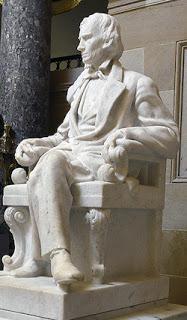

The statue at left is of Jefferson Davis, the president of the Confederacy. The statue on the right is of Alexander Hamilton Stephens, the vice-president of the confederacy.
These statues are not in some history museum. They are in the Capitol building in Washington, D.C.
They are among 11 statues of Confederate officials and soldiers that are desecrating the U.S. Capitol.
I know there are those who claim they represent our heritage, but what heritage? Do we really want to glorify a heritage of hate and racism. These men fought to. keep slavery legal. They believed in the supremacy of Whites. There is no doubt of this. It is in the constitutions of the states that made up the Confederacy.
And they were traitors. They actively worked against the United States of America. These 11 men should not be honored. They should be vilified.
Speaker Nancy Pelosi has asked that the statues be removed from the Capitol building. States could replace them with real American heroes (each state donates two statues to be exhibited in the Capitol). She is right! The statues symbolize the racism that is too prevalent in this country. They must go!
Here,
from KIRO7.com, is a list of the 11 states that should be removed:
Jefferson Davis, statue donated by Mississippi: Davis, who owned a cotton plantation in Mississippi before the Civil War, was the president of the Confederate States of America during the war.
James Zachariah George, statue donated by Mississippi: George was a leader in the state during Reconstruction and was a staunch white supremacist. Called the “Great Commoner,” George was a lawyer and a member of the Mississippi Secession Convention. He signed the state’s Secession Ordinance.
Wade Hampton, statue donated by South Carolina: Hampton was one of the largest slaveholders in the Southeast prior to the war. He fought for the Confederacy, reaching the rank of lieutenant general. After the war, he became the leader of the Redeemers, a political coalition that hoped to enforce white supremacy in all aspects of life. Hampton, a Democrat, was elected governor of South Carolina in a campaign that became known for its violence against black and Republican voters.
John E. Kenna, statue donated by West Virginia: Kenna was 16 years old when he fought for the Confederacy. He was wounded, and when he returned home, he dedicated himself to becoming a lawyer. He was a prosecuting attorney and then a judge. Kenna, a Democrat, was elected to the U.S. House in 1876 and to the U.S. Senate in 1883. He died in office at age 44.
Robert E. Lee, statue donated by Virginia: Lee, a graduate of West Point, was the commander of the Confederate States Army. Lee married into one of the wealthiest slaveholding families in Virginia – the Custis family. Upon the death of his father-in-law, Lee was charged with managing Custis’ estate. He would eventually free Custis’ slaves, five years after Custis’ death, per the orders in his will. Lee also owned slaves.
Uriah Milton Rose, statue donated by Arkansas: Rose, an attorney, was a strong supporter of the Confederacy. He became chairman of the Resolutions Committee of the state Democratic Party, determined "to preserve 'white man’s” government in a “white man’s country.” He served as president of the American Bar Association. He helped found the Rose Law Firm, where Hilary Clinton was a partner.
Edmund Kirby Smith, statue donated by Florida: Smith was born into a wealthy slave-owning family in St. Augustine, Florida. After serving in the U.S. Army during the Mexican–American War, he joined the Confederate States Army to fight in the Civil War. Eventually, he would command the Trans-Mississippi Department after the fall of Vicksburg to Union forces. He was the last Confederate general to surrender after the end of the Civil War.
Alexander Hamilton Stephens, statue donated by Georgia: Stephens was a Confederate politician who served as the vice president of the Confederate States. He was a Democratic representative in the U.S. House and was the governor of Georgia from 1882 until his death in 1883.
Zebulon Baird Vance, statue donated by North Carolina: Vance was a member of the Confederate military before being elected governor of North Carolina and the U.S. Senate. Vance favored the modernization of the Southern economy following the war.
Joseph Wheeler, statue donated by Alabama: Wheeler was a commander in the Confederate Army of Tennessee before he served as a general in the United States Army during both the Spanish–American War and Philippine–American War.
Edward Douglass White, statue donated by Louisiana: White was captured during the Civil War as he was fighting for the Confederacy. After the war, he was elected to the Louisiana state Senate and served on the Louisiana Supreme Court. A Democrat, White represented Louisiana in the United States Senate and was appointed an associate justice of the U.S. Supreme Court. A few years later, President William Howard Taft appointed him chief justice of the Supreme Court.

 The statue at left is of Jefferson Davis, the president of the Confederacy. The statue on the right is of Alexander Hamilton Stephens, the vice-president of the confederacy.
The statue at left is of Jefferson Davis, the president of the Confederacy. The statue on the right is of Alexander Hamilton Stephens, the vice-president of the confederacy.
